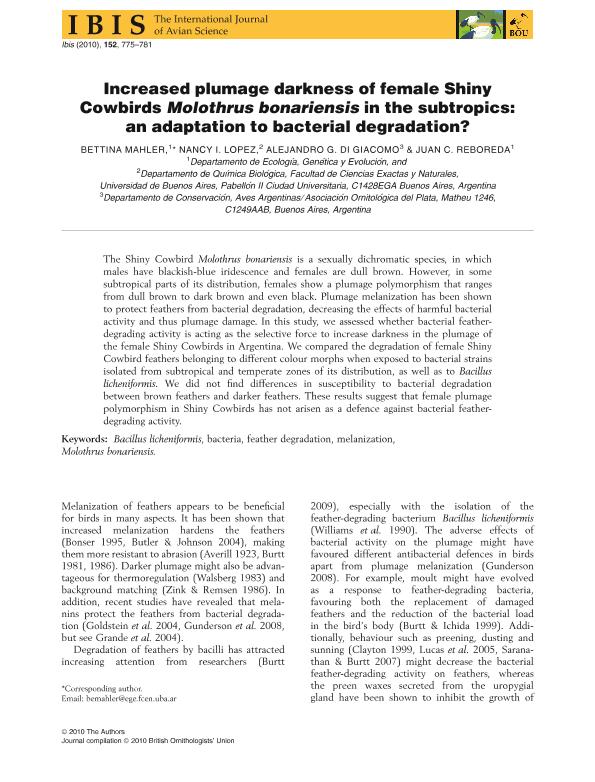Mostrar el registro sencillo del ítem
dc.contributor.author
Mahler, Bettina

dc.contributor.author
López, Nancy Irene

dc.contributor.author
Di Giacomo, Alejandro G.

dc.contributor.author
Reboreda, Juan Carlos

dc.date.available
2018-12-04T13:50:10Z
dc.date.issued
2010-10
dc.identifier.citation
Mahler, Bettina; López, Nancy Irene; Di Giacomo, Alejandro G.; Reboreda, Juan Carlos; Increased plumage darkness of female Shiny Cowbirds Molothrus bonariensis in the subtropics: An adaptation to bacterial degradation?; Wiley Blackwell Publishing, Inc; Ibis; 152; 4; 10-2010; 775-781
dc.identifier.issn
0019-1019
dc.identifier.uri
http://hdl.handle.net/11336/65692
dc.description.abstract
The Shiny Cowbird Molothrus bonariensis is a sexually dichromatic species, in which males have blackish-blue iridescence and females are dull brown. However, in some subtropical parts of its distribution, females show a plumage polymorphism that ranges from dull brown to dark brown and even black. Plumage melanization has been shown to protect feathers from bacterial degradation, decreasing the effects of harmful bacterial activity and thus plumage damage. In this study, we assessed whether bacterial feather-degrading activity is acting as the selective force to increase darkness in the plumage of the female Shiny Cowbirds in Argentina. We compared the degradation of female Shiny Cowbird feathers belonging to different colour morphs when exposed to bacterial strains isolated from subtropical and temperate zones of its distribution, as well as to Bacillus licheniformis. We did not find differences in susceptibility to bacterial degradation between brown feathers and darker feathers. These results suggest that female plumage polymorphism in Shiny Cowbirds has not arisen as a defence against bacterial feather-degrading activity. © 2010 The Authors. Journal compilation © 2010 British Ornithologists' Union.
dc.format
application/pdf
dc.language.iso
eng
dc.publisher
Wiley Blackwell Publishing, Inc

dc.rights
info:eu-repo/semantics/openAccess
dc.rights.uri
https://creativecommons.org/licenses/by-nc-sa/2.5/ar/
dc.subject
Bacillus Licheniformis
dc.subject
Bacteria
dc.subject
Feather Degradation
dc.subject
Melanization
dc.subject
Molothrus Bonariensis
dc.subject.classification
Otras Ciencias Biológicas

dc.subject.classification
Ciencias Biológicas

dc.subject.classification
CIENCIAS NATURALES Y EXACTAS

dc.title
Increased plumage darkness of female Shiny Cowbirds Molothrus bonariensis in the subtropics: An adaptation to bacterial degradation?
dc.type
info:eu-repo/semantics/article
dc.type
info:ar-repo/semantics/artículo
dc.type
info:eu-repo/semantics/publishedVersion
dc.date.updated
2018-11-22T15:29:07Z
dc.journal.volume
152
dc.journal.number
4
dc.journal.pagination
775-781
dc.journal.pais
Reino Unido

dc.journal.ciudad
Londres
dc.description.fil
Fil: Mahler, Bettina. Consejo Nacional de Investigaciones Científicas y Técnicas; Argentina. Universidad de Buenos Aires. Facultad de Ciencias Exactas y Naturales. Departamento de Ecología, Genética y Evolución; Argentina
dc.description.fil
Fil: López, Nancy Irene. Consejo Nacional de Investigaciones Científicas y Técnicas; Argentina. Universidad de Buenos Aires. Facultad de Ciencias Exactas y Naturales. Departamento de Química Biológica; Argentina
dc.description.fil
Fil: Di Giacomo, Alejandro G.. Asociación Ornitológica del Plata; Argentina
dc.description.fil
Fil: Reboreda, Juan Carlos. Consejo Nacional de Investigaciones Científicas y Técnicas; Argentina. Universidad de Buenos Aires. Facultad de Ciencias Exactas y Naturales. Departamento de Ecología, Genética y Evolución; Argentina
dc.journal.title
Ibis

dc.relation.alternativeid
info:eu-repo/semantics/altIdentifier/doi/https://dx.doi.org/10.1111/j.1474-919X.2010.01044.x
dc.relation.alternativeid
info:eu-repo/semantics/altIdentifier/url/https://onlinelibrary.wiley.com/doi/abs/10.1111/j.1474-919X.2010.01044.x
Archivos asociados
